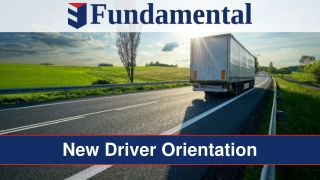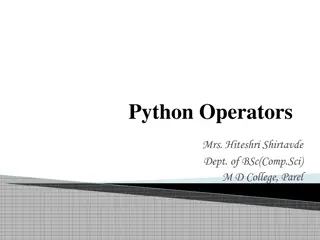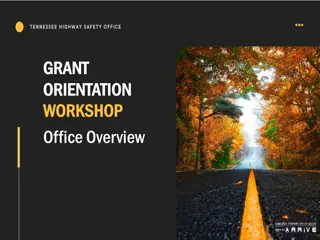Entry-Level Driver Training Program for CDL Operators in Pennington County Highway Department
The Pennington County Highway Department offers an Entry-Level Driver Training Program for CDL operators to enhance safety and reduce accidents. The program abides by the ELDT regulation for CDLs, ensuring all new drivers receive comprehensive training covering Theory and Behind the Wheel aspects. Compliance is mandatory by February 7, 2022, with training data reported to FMCSA. The ELDT Rule under 49 CFR part 380 applies to both intrastate and interstate drivers, with established curriculum subdivisions and specific training provider qualifications.
Download Presentation

Please find below an Image/Link to download the presentation.
The content on the website is provided AS IS for your information and personal use only. It may not be sold, licensed, or shared on other websites without obtaining consent from the author.If you encounter any issues during the download, it is possible that the publisher has removed the file from their server.
You are allowed to download the files provided on this website for personal or commercial use, subject to the condition that they are used lawfully. All files are the property of their respective owners.
The content on the website is provided AS IS for your information and personal use only. It may not be sold, licensed, or shared on other websites without obtaining consent from the author.
E N D
Presentation Transcript
Pennington County Highway Department Overview Entry-Level Driver Training Program for (CDL) operators
Origins Why? Studies proved that accidents and violations were significantly less for operators that were properly trained and certified. Based on this criterion, the Federal Motor Carrier Safety Administration (FMCSA) implemented federally mandated training for all new drivers. What? ELDT (Entry Level Driver Training) regulation for CDLs How? Specified program of instruction which covers regulation for CDL s Theory and Behind the Wheel (BTW) Applies to: First time CDL applicants (Class A or B) Upgrade to a Class A or Class B CDL Hazardous Materials, Passenger, and School Bus Endorsements
Compliance Date: February 7, 2022 New CDL s only issued to persons completing federally compliant training Training must include all required Theory (classroom) content Training must include all required BTW (behind the wheel) training Training must include and document comprehensive testing/assessment Training data must be reported to the Federal Motor Carrier Safety Administration (FMCSA)
Summary of major provisions ELDT Rule is found in 49 CFR part 380 (Code of Federal Regulations) Known as the Federal Motor Carrier Safety Regulations. Applies to both intrastate and interstate drivers. Established curriculum is subdivided into Theory and BTW. Theory and BTW may be provided by different training providers or at different training sites, as applicable. Training materials follow the information presented in the following publications: South Dakota Commercial Drivers License Manual SD DOT Commercial & Agricultural Vehicle Handbook
Training Providers Individual who provides knowledge instruction on the operation of a CMV and meets one of these qualifications: Holds CDL of same or higher class, 2 years CMV driving experience & meets state requirements for a CMV instructor Holds CDL of same or higher class, 2 years experience as a CMV instructor & meets state requirements for a CMV instructor Is prohibited from engaging in BTW instruction, for 2 years, if CDL has been cancelled, suspended or revoked for any disqualifying offense ( 383.51) Must provide instruction in a curriculum that meets the ELDT rule Must meet eligibility requirements to be listed on the Training Provider s Registry (TPR) Must attest that they meet the requirements Must be able to supply records and documentation in the event of a FMCSA audit
Theory Instruction (classroom) No minimum number of hours on theory units, however Instruction in all required elements of theory must be provided Comprehensive testing/assessment must be conducted Trainees must score a minimum of 80% overall score on theory test(s) All test results are maintained as verifiable records.
Curriculum Structure Section 1.1 theory Section A/B1.1 - Basic Operation Unit A/B1.1.1 - Orientation Unit A/B1.1.2 - Control systems/dashboard Unit A/B1.1.3 - Pre- and post-trip inspections Unit A/B1.1.4 - Basic control Unit A/B1.1.5 - Shifting/operating transmissions Unit A/B1.1.6 - Backing and docking Unit A/B1.1.7 - Coupling and uncoupling (Class A CDL only)
Curriculum Structure Section 1.2 theory Section A/B1.2 Safe Operating Procedures Unit A/B1.2.1 Visual Search Unit A/B1.2.2 - Communication Unit A/B1.2.3 Distracted Driving Unit A/B1.2.4 Speed Management Unit A/B1.2.5 Space Management Unit A/B1.2.6 Night Operation Unit A/B1.2.7 Extreme Driving Conditions
Curriculum Structure Section 1.3 and 1.4 theory Section A/B1.3 Advanced Operating Procedures Unit A/B1.3.1 Hazard Perception Unit A/B1.3.2 Skid Control/Recovery, Jackknifing and Other Emergencies Unit A/B1.3.3 Railroad-Highway Grade Crossings Section A/B1.4 Vehicle Systems and Reporting Malfunctions Unit A/B1.4.1 Identification and Diagnosis of Malfunctions Unit A/B1.4.2 Roadside Inspections Unit A/B1.4.3 Maintenance
Curriculum Structure Section 1.5 theory Section A/B1.5 Non-Driving Activities Unit A/B1.5.1 Handling and Documenting Cargo Unit A/B1.5.2 Environmental Compliance Issues Unit A/B1.5.3 Hours of Service Requirements Unit A/B1.5.4 Fatigue and Wellness Awareness Unit A/B1.5.5 Post-Crash Procedures Unit A/B1.5.6 External Communications Unit A/B1.5.7 Whistleblower/Coercion Unit A/B1.5.8 Trip Planning Unit A/B1.5.9 Drugs/Alcohol Unit A/B1.5.10 Medical Requirements
BTW Range and Public Road Training Definition BTW Training means Active Control Training provided by a BTW instructor with an Entry- Level-Driver-Trainee requires that actual control of the power be given to the student during a driving lesson. BTW training does not include time an Entry-Level- Driver-Trainee spends observing the operation of a CMV when he or she is not in control of the vehicle.
Curriculum Curriculum Structure BTW range BTW range Section A/B2 Behind-The-Wheel - Range Unit A/B 2.1 Vehicle Inspection Pre-trip/Enroute/Post-trip Unit A/B 2.2 Straight Line Backing Unit A/B 2.3 Alley Docking (45/90 degree) Unit A/B 2.4 Off-Set Backing Unit A/B 2.5 Parallel Parking Blind Side Unit A/B 2.6 Parallel Parking Sight Side Unit A/B 2.7 Coupling and Uncoupling (Class A Only)
Curriculum Structure Behind The-wheel public road Section A/B3 Behind-The-Wheel Public Road Unit A/B 3.1 Vehicle Controls Unit A/B 3.2 Shifting/Transmission Unit A/B 3.3 Communications/Signaling Unit A/B 3.4 Visual Search Unit A/B 3.5 Speed and Space Management Unit A/B 3.6 Safe Driver Behavior Unit A/B 3.7 Hours of Service Requirements Unit A/B 3.8 Hazard Perception Unit A/B 3.9 Railroad-Highway Grade Crossing Unit A/B 3.10 Night Operation Unit A/B 3.11 Extreme Driving Conditions Unit A/B 3.12 - Skid Control/Recovery, Jackknifing and Other Emergencies
BTW Instruction No minimum number of hours on BTW units, however Instruction in all required elements of BTW training must be provided Driver-trainees must demonstrate proficiency in all BTW requirements **Proficiency means repeated demonstration of each required** skill (i.e... No One & Done ) Suggested time frame for lessons are provided Documentation of each practical exercise is completed daily
Training certification After an individual completes training the provider must, by midnight of the second business day after the driver-trainee completes the training, electronically transmit training certification information through the TPR website (Training Providers Registry) including the following: Driver-trainee name, number of driver s license/commercial learner s permit/commercial driver s license, as applicable, and State of licensure; Commercial driver s license class and/or endorsement and type of training (theory and/or BTW) the driver-trainee completed; Total number of clock hours the driver-trainee spent to complete BTW training, as applicable; Name of the training provider and its unique TPR identification number; and Date(s) of successful training completion.
Pennington County Highway Department All new hires without a valid class A CDL are scheduled to complete the training program. The CDL course is based on 240 hours of instruction. (80 hours classroom and 160 (+/-) hours behind the wheel. New hire must have basic testing and learners permit from SD DMV by the first day of employment. It is expected that new hires complete the training program, successfully pass the DMV evaluation and acquire a Class A CDL license within 90 days of employment.























